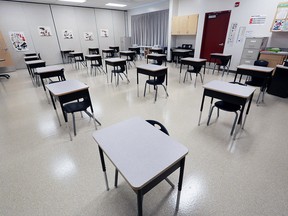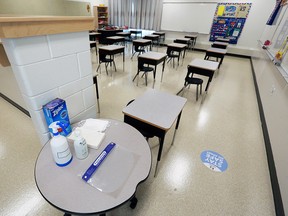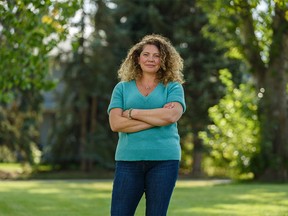
Article content
School staff are working double – sometimes triple – duty after the UCP created a new regulation forcing school boards to ensure all students have access to personalized learning, no matter how high absences become.
Advertisement 2
Article content
An ongoing wave of respiratory illnesses — which this week had Alberta Children’s Hospital parking a trailer outside emergency rooms to wait for overflow — is causing high absenteeism rates among students and staff in Calgary schools, forcing some to switch students to online learning.
Article content
And just one week after the UCP government announced a new regulation ensuring all students have access to in-class learning, the Calgary Board of Education reports more than 1,200 teaching and support staff positions need replacements.
Jason Schilling, president of the Alberta Teachers’ Association, said schools now face even more obstacles trying to support students, with staff still remaining in schools teaching both online and in-person while taking on the students of sick colleagues.
Advertisement 3
Article content
“When the government thinks this new regulation is a solution for students, it actually creates more problems, it makes them worse,” Schilling said.
“Classes moved online in the first place because operationally, school boards just don’t have the staff to run classrooms.
“And this new requirement has teachers running both online and in-person components for their students, but also having to cover for colleagues who may be sick.
“So they actually work double, sometimes triple duty.”

Schilling explained that teachers who may have most of their students sick, but a handful are still healthy, now have to be in the classroom during the day to give in-person lessons.
But outside of school hours, Schilling added, those same teachers must connect with students who want to learn from home and ensure they understand concepts, have lesson plans and have the technology they need.
Advertisement 4
Article content
And when teachers themselves get sick, students are moved to other already full classrooms where students can learn different concepts, or even in a different grade, Schilling said.
“All of this also affects learning and makes it difficult for students who are still experiencing so much disruption.”
Last week, Premier Danielle Smith and Education Minister Adriana LaGrange announced two new regulations, one that would prevent school boards from mandating masks, and another that would ensure that school boards provide personalized learning opportunities for all students.
“Parents and students have told me time and time again that they want a normal school environment for their children. With this in mind, we have taken steps to protect and enhance educational choice. Families are free to make their own personal health decisions, and no matter what that decision is, it will be supported by Alberta’s education system,” said Smith.
Advertisement 5
Article content
LaGrange added she has also received feedback from schools and families.
“I’ve heard from parents and students that they want stability, and from school boards that they want clarity. Ensuring a face-to-face classroom environment means students can continue to learn successfully while allowing their parents to go to work. It will also help to maintain and improve students’ mental health, while minimizing students’ learning loss.”
-

The Government of Alberta only restricts online learning in schools
-

Alberta Children’s Hospital installs heated trailer outside ER to meet patient surge
-

‘Nothing is being done’: Parents struggle with sick children because the province bans mask mandates
But Stephen Clementspresident of the Alberta Teachers’ Association Local 38 that represents Calgary public school teachers, said the new rules will actually add stress to the system and make learning even more challenging.
Advertisement 6
Article content
“I’m dumbfounded. I mean, you can’t just photoshop teachers,” Clements said.
“We heard our own superintendent say just two weeks ago that online learning is something that might have to happen because we just don’t have enough staff, and in the worst case, we might end up teaching some kids online for a few must sit. days.
“And now we hear we can’t do it.”
Clements said this fall has already been incredibly difficult, with the CBE welcoming a large influx of new students, and teachers being required to implement a new curriculum for K-to-6 students.
“How can teachers ensure that all the learning outcomes of this new curriculum are even achieved, when so many children and staff are away because they are sick?
“Every day we hear that teachers cover colleagues who are sick, we combine classes all the time. And there is no safety net like the one we had during COVID, when at least the CMOH (Chief Medical Officer of Health) could say that we need masking, or we can move online.
Advertisement 7
Article content
“That’s gone now, and this government keeps trying to push forward as if it’s business as usual.”
Medeana Moussa, spokeswoman for the Support Our Students advocacy group, called the new UCP regulations political grandstanding, at a time when students face ongoing disruptions and learning loss.
“There is nothing normal about the school environment that this government has created by not investing in schools, not investing in health and safety metrics,” Moussa said, explaining that underfunding has caused large class sizes and a lack of staff , which aggravates infectious diseases. .

“Parents are scrambling and doing whatever they can to make sure their children stay healthy and don’t miss any more school.
Advertisement 8
Article content
“And where is the advocacy of the CBE? They continue to fall in line and allow the government to do what they want without standing up for students.”
CBE officials continue to track student absences, which this week showed an average of 10 percent absenteeism among younger K-to-3 students.
By mid-week, the CBE had identified 1,212 posts requiring substitute teachers or casual staff. Of these, 122 teaching positions are unfilled, and 54 support staff positions are also unfilled.
At the Calgary Catholic School District, 49 of 117 schools had absenteeism rates of 10 per cent or higher, up from 46 last week and 93 staff positions were not filled.
Neither school board would provide a detailed strategy of how they deal with a high rate of staff absences and how the new regulations will affect learning, saying only that they continue to take their lead from the province.
eferguson@postmedia.com

